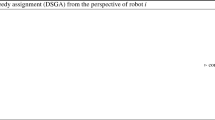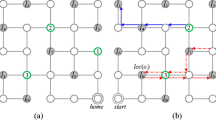Abstract
This paper develops a new approach to direct a set of heterogeneous agents, varying in mobility and sensing capabilities, to quickly cover a large region, say for example in the search for victims after a large-scale disaster. Given that time is of the essence, we seek to mitigate computational complexity, which normally grows exponentially as the number of agents increases. We create a new framework which reduces the planning complexity through simultaneously decomposing a target domain into sub-regions, and assigning a team of agents to each sub-region in the target domain, as a way to decompose a large-scale problem into a set of smaller problems. The teams are formed to optimize the coverage of each sub-regions. Doing so requires both the utilization of individual agents’ strengths as well as their collaborative capabilities. We determine the ideal team by introducing a novel evolution-guided generative model based on generative adversarial networks (GANs) that creates allocation plans from the sub-region features in a computationally efficient manner. We validate our framework on a real-world satellite images dataset, and demonstrate that through decomposition and generative allocation, our method has significantly better efficiency and efficacy compared to current centralized multi-robot coverage methods, and is therefore better suited for large-scale time-critical deployment.
Access this chapter
Tax calculation will be finalised at checkout
Purchases are for personal use only
Similar content being viewed by others
References
Abraham, I., Mavrommati, A., Murphey, T.: Data-driven measurement models for active localization in sparse environments. In: Proceedings of Robotics: Science and Systems. Pittsburgh, Pennsylvania (2018)
Agarap, A.F.: Deep learning using rectified linear units (relu) (2018). arXiv:1803.08375
Agarwal, M., Agrawal, N., Sharma, S., Vig, L., Kumar, N.: Parallel multi-objective multi-robot coalition formation. Expert Syst. Appl. 42(21), 7797–7811 (2015)
Arjovsky, M., Chintala, S., Bottou, L.: Wasserstein generative adversarial networks. In: International Conference on Machine Learning, pp. 214–223. PMLR (2017)
Ayvali, E., Ansari, A., Wang, L., Simaan, N., Choset, H.: Utility-guided palpation for locating tissue abnormalities. IEEE Robot. Autom. Lett. 2(2), 864–871 (2017)
Ayvali, E., Salman, H., Choset, H.: Ergodic coverage in constrained environments using stochastic trajectory optimization. In: 2017 IEEE/RSJ International Conference on Intelligent Robots and Systems (IROS), pp. 5204–5210. IEEE (2017)
Badreldin, M., Hussein, A., Khamis, A.: A comparative study between optimization and market-based approaches to multi-robot task allocation. Adv. Artif. Intell. (16877470) (2013)
Casas, N.: Genetic algorithms for multimodal optimization: a review (2015). arXiv:1508.05342
Črepinšek, M., Liu, S.H., Mernik, M.: Exploration and exploitation in evolutionary algorithms: a survey. ACM Comput. Surv. (CSUR) 45(3), 1–33 (2013)
Deb, K., Pratap, A., Agarwal, S., Meyarivan, T.: A fast and elitist multiobjective genetic algorithm: Nsga-ii. IEEE Trans. Evol. Comput. 6(2), 182–197 (2002)
Dorigo, M., Birattari, M., Stutzle, T.: Ant colony optimization. IEEE Comput. Intell. Mag. 1(4), 28–39 (2006)
Goodfellow, I.J., Pouget-Abadie, J., Mirza, M., Xu, B., Warde-Farley, D., Ozair, S., Courville, A.C., Bengio, Y.: Generative adversarial nets. In: Neural Information Processing Systems (2014)
Gulrajani, I., Ahmed, F., Arjovsky, M., Dumoulin, V., Courville, A.C.: Improved training of wasserstein gans. Adv. Neural Inf. Process. Syst. 30 (2017)
Ioffe, S., Szegedy, C.: Batch normalization: accelerating deep network training by reducing internal covariate shift. In: International conference on machine learning, pp. 448–456. PMLR (2015)
Kantaros, Y., Zavlanos, M.M.: Distributed communication-aware coverage control by mobile sensor networks. Automatica 63, 209–220 (2016)
Katoch, S., Chauhan, S.S., Kumar, V.: A review on genetic algorithm: past, present, and future. In: Multimedia Tools and Applications, pp. 1–36 (2020)
Kennedy, J., Eberhart, R.: Particle swarm optimization. In: Proceedings of ICNN’95-International Conference on Neural Networks, vol. 4, pp. 1942–1948. IEEE (1995)
Khamis, A., Hussein, A., Elmogy, A.: Multi-robot task allocation: a review of the state-of-the-art. Coop. Robot. Sens. Netw. 2015, 31–51 (2015)
Kingma, D.P., Ba, J.: Adam: A method for stochastic optimization (2014). arXiv:1412.6980
Korsah, G.A., Stentz, A., Dias, M.B.: A comprehensive taxonomy for multi-robot task allocation. Int. J. Robot. Res. 32(12), 1495–1512 (2013)
Levina, E., Bickel, P.: The earth mover’s distance is the mallows distance: some insights from statistics. In: Proceedings Eighth IEEE International Conference on Computer Vision, ICCV 2001. vol. 2, pp. 251–256. IEEE (2001)
Li, M., Chen, T., Yao, X.: How to evaluate solutions in pareto-based search-based software engineering? a critical review and methodological guidance. IEEE Trans. Softw. Eng. 1 (2020)
Liu, C., Kroll, A.: A centralized multi-robot task allocation for industrial plant inspection by using a* and genetic algorithms. In: International Conference on Artificial Intelligence and Soft Computing, pp. 466–474. Springer, Berlin (2012)
Liu, H.Y., Chen, J.F.: Multi-robot cooperation coalition formation based on genetic algorithm. In: 2006 International Conference on Machine Learning and Cybernetics, pp. 85–88. IEEE (2006)
Liu, Y., Wang, W., Lévy, B., Sun, F., Yan, D.M., Lu, L., Yang, C.: On centroidal Voronoi tessellation-energy smoothness and fast computation. ACM Trans. Graph. (ToG) 28(4), 1–17 (2009)
López-González, A., Campaña, J.M., Martínez, E.H., Contro, P.P.: Multi robot distance based formation using parallel genetic algorithm. Appl. Soft Comput. 86, 105929 (2020)
Mathew, G., Mezić, I.: Metrics for ergodicity and design of ergodic dynamics for multi-agent systems. Phys. D 240(4–5), 432–442 (2011)
Mavrommati, A., Tzorakoleftherakis, E., Abraham, I., Murphey, T.D.: Real-time area coverage and target localization using receding-horizon ergodic exploration. IEEE Trans. Rob. 34(1), 62–80 (2017)
Miller, L.M., Silverman, Y., MacIver, M.A., Murphey, T.D.: Ergodic exploration of distributed information. IEEE Trans. Rob. 32(1), 36–52 (2015)
Mirza, M., Osindero, S.: Conditional generative adversarial nets (2014). arXiv:1411.1784
Mouradian, C., Sahoo, J., Glitho, R.H., Morrow, M.J., Polakos, P.A.: A coalition formation algorithm for multi-robot task allocation in large-scale natural disasters. In: 2017 13th International Wireless Communications and Mobile Computing Conference (IWCMC), pp. 1909–1914. IEEE (2017)
Pilkington, N., Svetlichnaya, S., Holmes, T.: Github—dronedeploy/ddml-segmentation-benchmark: dronedeploy machine learning segmentation benchmark (2019)
Price, K.V.: Differential evolution. In: Handbook of Optimization, pp. 187–214. Springer, Berlin (2013)
Prorok, A., Hsieh, M.A., Kumar, V.: Fast redistribution of a swarm of heterogeneous robots. In: Proceedings of the 9th EAI International Conference on Bio-Inspired Information and Communications Technologies (Formerly BIONETICS), pp. 249–255. BICT’15 (2016)
Rauniyar, A., Muhuri, P.K.: Multi-robot coalition formation and task allocation using immigrant based adaptive genetic algorithms. In: Computational Intelligence in Emerging Technologies for Engineering Applications, pp. 205–225. Springer, Berlin (2020)
Shehory, O., Kraus, S.: Methods for task allocation via agent coalition formation. Artif. Intell. 101(1–2), 165–200 (1998)
Van Veldhuizen, D.A., Lamont, G.B.: Multiobjective evolutionary algorithms: analyzing the state-of-the-art. Evol. Comput. 8(2), 125–147 (2000)
Van Veldhuizen, D.A., Lamont, G.B., et al.: Evolutionary computation and convergence to a pareto front. In: Late Breaking Papers at the Genetic Programming 1998 Conference, pp. 221–228. Citeseer (1998)
Wang, J., Gu, Y., Li, X.: Multi-robot task allocation based on ant colony algorithm. J. Comput. 7(9), 2160–2167 (2012)
Wei, C., Ji, Z., Cai, B.: Particle swarm optimization for cooperative multi-robot task allocation: a multi-objective approach. IEEE Robot. Autom. Lett. 5(2), 2530–2537 (2020)
Xu, B., Yang, Z., Ge, Y., Peng, Z.: Coalition formation in multi-agent systems based on improved particle swarm optimization algorithm. Int. J. Hybrid Inf. Technol. 8(3), 1–8 (2015)
Yusoff, Y., Ngadiman, M.S., Zain, A.M.: Overview of NSGA-II for optimizing machining process parameters. Procedia Eng. 15, 3978–3983 (2011)
Zitzler, E., Thiele, L.: Multiobjective evolutionary algorithms: a comparative case study and the strength pareto approach. IEEE Trans. Evol. Comput. 3(4), 257–271 (1999)
Author information
Authors and Affiliations
Corresponding author
Editor information
Editors and Affiliations
Rights and permissions
Copyright information
© 2023 The Author(s), under exclusive license to Springer Nature Switzerland AG
About this paper
Cite this paper
Hu, J., Coffin, H., Whitman, J., Travers, M., Choset, H. (2023). Large-Scale Heterogeneous Multi-robot Coverage via Domain Decomposition and Generative Allocation. In: LaValle, S.M., O’Kane, J.M., Otte, M., Sadigh, D., Tokekar, P. (eds) Algorithmic Foundations of Robotics XV. WAFR 2022. Springer Proceedings in Advanced Robotics, vol 25. Springer, Cham. https://doi.org/10.1007/978-3-031-21090-7_4
Download citation
DOI: https://doi.org/10.1007/978-3-031-21090-7_4
Published:
Publisher Name: Springer, Cham
Print ISBN: 978-3-031-21089-1
Online ISBN: 978-3-031-21090-7
eBook Packages: Intelligent Technologies and RoboticsIntelligent Technologies and Robotics (R0)




